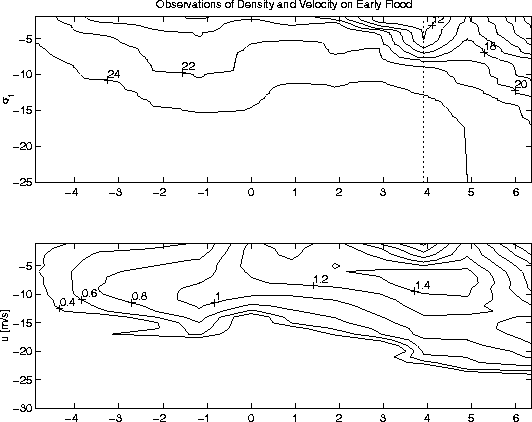Current Status of My Thesis Work
1997 November 12

The Columbia River Entrance channel

My observations in the Columbia River entrance channel reveal a partial
breakdown of the traditional inviscid model of two-layer exchange.
An along-channel section of measured density shows internal hydraulic
control at a lateral constriction in the channel (dotted vertical line
in figure 2a).
The pycnocline, whose finite thickness is not part of
two-layer theory, is distinctly thinner at the constriction. Observed
early flood currents, which are strongest at mid-depth show a greater
departure from two-layer theory (figure 2b).
Whereas the classical
model suggests that flood currents should be strongest in the lower
layer, observed flood currents migrate upward through the water column,
due to a combination of interfacial mixing and bottom friction. The
mixing thickens the pycnocline, while the friction retards bottom
currents, so the fastest currents are seen at or above mid-depth.

Figure 2: Observed Along-channel Section of Density and Salinity
Full color plot
I developed a time dependent numerical model of three layer
along-channel circulation in an estuarine channel, with the specific
goal of recreating the observed vertical distribution of flood currents.
Model development closely followed Helfrich's (1995) work on a rigid
lid two layer exchange model. The model is driven by an imposed
barotropic transport, which may be steady or vary tidally. The middle
layer is assumed to grow due to turbulent entrainment from the other
two layers, with a Richardson number dependent entrainment velocity
borrowed from Ellison and Turner (1959). Here I show results of a model
run using tidally-varying currents through a constricted channel, with
significant vertical mixing and bottom friction. The pycnocline is
thinner at the constriction (figure 3a); the model constriction
is less sharp than the real constriction, which is reflected in
the more gradual thinning of the pycnocline. The figure represents
conditions at early flood, and the middle layer is moving faster,
as observed (figure 3b).
This landward jet is thinner than observed,
because the layer model cannot represent both a thin pycnocline and a
thick velocity layer. Due to an initial condition on the vertical
shear, the seaward end of the surface layer is ebbing; this
non-physical result will be addressed in later model tests.

Figure 3: Along channel section of density and velocity
from a three-layer model

References
Ellison and Turner, 1959, Turbulent entrainment in stratified flows,
Journal of Fluid Mechanics, 6, 423-448
Helfrich, 1995, Time-dependent two-layer hydraulic exchange flows,
Journal of Physical Oceanography, 25, 359-373





